The Effects of Post Heat Treatment on the Microstructural and Mechanical Properties of an Additive-Manufactured Porous Titanium Alloy
Abstract
1. Introduction
2. Materials and Methods
2.1. Design of Porous Structure
2.2. Materials and Manufacturing
2.3. Microstructural Observation
2.4. Mechanical Testing
3. Results and Discussion
3.1. Morphology of Porous Ti64 Structure
3.2. Microstructure
3.3. Mechanical Properties
3.3.1. Compression Tests of Porous Structures
3.3.2. Gibson–Ashby Model
3.3.3. Energy Absorption Characteristics
4. Conclusions
- (1)
- The microstructure of the as-built samples is mainly composed of needle-shaped α′ martensite. After heat treatment at 750 °C, the needle-shaped α′ martensite transformed into lamellar α + β microstructure. As the heat treatment temperature increased from room temperature to 950 °C, the width of lamellar α phase gradually increased from 0.3 to 3.1 μm.
- (2)
- The increase in heat treatment temperature could gradually reduce the compressive strength and yield strength of the porous Ti64 structure. The mechanical properties of the porous structures with low porosity were more sensitive to the heat-treatment temperature, but the heat treatment processing hardly affected the elastic moduli of the porous structures.
- (3)
- The energy absorption condition of porous Ti64 structure could be more stable after heat treatment. Heat treatment at 750 °C improved the energy absorption capabilities of the porous Ti64 structures. The samples with porosity of 46.3% had the highest energy absorption at ε = 50% (233.6 ± 1.5 MJ/m3) after being heat-treated at 750 °C for 2 h.
Author Contributions
Funding
Acknowledgments
Conflicts of Interest
References
- Ashby, M.F.; Gibson, L.J. Cellular solids structure and properties; Press Synd. Univ. Cambridge: Cambridge, UK, 1997; pp. 175–231. [Google Scholar]
- Wang, X.; Jiang, M.; Zhou, Z.; Gou, J.; Hui, D. 3D printing of polymer matrix composites: A review and prospective. Compos. Part B Eng. 2017, 110, 442–458. [Google Scholar] [CrossRef]
- Pinto, S.C.; Marques, P.A.A.P.; Vesenjak, M.; Vicente, R.; Godinho, L.; Krstulović-Opara, L.; Duarte, I. Characterization and physical properties of aluminium foam–polydimethylsiloxane nanocomposite hybrid structures. Compos. Struct. 2019, 230, 111521. [Google Scholar] [CrossRef]
- Hollister, S.J. Porous scaffold design for tissue engineering. Nat. Mater. 2005, 4, 518–524. [Google Scholar] [CrossRef] [PubMed]
- Li, Y.; Jahr, H.; Pavanram, P.; Bobbert, F.S.L.; Puggi, U.; Zhang, X.Y.; Pouran, B.; Leeflang, M.A.; Weinans, H.; Zhou, J.; et al. Additively manufactured functionally graded biodegradable porous iron. Acta Biomater. 2019, 96, 646–661. [Google Scholar] [CrossRef] [PubMed]
- Zhang, X.-Y.; Fang, G.; Leeflang, S.; Zadpoor, A.A.; Zhou, J. Topological design, permeability and mechanical behavior of additively manufactured functionally graded porous metallic biomaterials. Acta Biomater. 2019, 84, 437–452. [Google Scholar] [CrossRef] [PubMed]
- Ma, S.; Tang, Q.; Feng, Q.; Song, J.; Han, X.; Guo, F. Mechanical behaviours and mass transport properties of bone-mimicking scaffolds consisted of gyroid structures manufactured using selective laser melting. J. Mech. Behav. Biomed. Mater. 2019, 93, 158–169. [Google Scholar] [CrossRef] [PubMed]
- Wang, Z.; Yan, F.; Pei, H.; Yan, K.; Cui, Z.; He, B.; Fang, K.; Li, J. Environmentally-friendly halloysite nanotubes@chitosan/polyvinyl alcohol/non-woven fabric hybrid membranes with a uniform hierarchical porous structure for air filtration. J. Memb. Sci. 2020, 594, 117445. [Google Scholar] [CrossRef]
- Mareze, P.H.; Brandão, E.; Fonseca, W.D.; Silva, O.M.; Lenzi, A. Modeling of acoustic porous material absorber using rigid multiple micro-ducts network: Validation of the proposed model. J. Sound Vib. 2019, 443, 376–396. [Google Scholar] [CrossRef]
- Aboulkhair, N.T.; Simonelli, M.; Parry, L.; Ashcroft, I.; Tuck, C.; Hague, R. 3D printing of Aluminium alloys: Additive Manufacturing of Aluminium alloys using selective laser melting. Prog. Mater. Sci. 2019, 106, 100578. [Google Scholar] [CrossRef]
- Liu, S.; Shin, Y.C. Additive manufacturing of Ti6Al4V alloy: A review. Mater. Des. 2019, 164, 107552. [Google Scholar] [CrossRef]
- Crupi, V.; Kara, E.; Epasto, G.; Guglielmino, E.; Aykul, H. Static behavior of lattice structures produced via direct metal laser sintering technology. Mater. Des. 2017, 135, 246–256. [Google Scholar] [CrossRef]
- Bobbert, F.S.L.; Lietaert, K.; Eftekhari, A.A.; Pouran, B.; Ahmadi, S.M.; Weinans, H.; Zadpoor, A.A. Additively manufactured metallic porous biomaterials based on minimal surfaces: A unique combination of topological, mechanical, and mass transport properties. Acta Biomater. 2017, 53, 572–584. [Google Scholar] [CrossRef] [PubMed]
- Kelly, C.N.; Francovich, J.; Julmi, S.; Safranski, D.; Guldberg, R.E.; Maier, H.J.; Gall, K. Fatigue behavior of As-built selective laser melted titanium scaffolds with sheet-based gyroid microarchitecture for bone tissue engineering. Acta Biomater. 2019, 94, 610–626. [Google Scholar] [CrossRef] [PubMed]
- Yan, X.; Li, Q.; Yin, S.; Chen, Z.; Jenkins, R.; Chen, C.; Wang, J.; Ma, W.; Bolot, R.; Lupoi, R.; et al. Mechanical and in vitro study of an isotropic Ti6Al4V lattice structure fabricated using selective laser melting. J. Alloys Compd. 2019, 782, 209–223. [Google Scholar] [CrossRef]
- Liang, Z.; Sun, Z.; Zhang, W.; Wu, S.; Chang, H. The effect of heat treatment on microstructure evolution and tensile properties of selective laser melted Ti6Al4V alloy. J. Alloys Compd. 2019, 782, 1041–1048. [Google Scholar] [CrossRef]
- Yan, X.; Yin, S.; Chen, C.; Huang, C.; Bolot, R.; Lupoi, R.; Kuang, M.; Ma, W.; Coddet, C.; Liao, H.; et al. Effect of heat treatment on the phase transformation and mechanical properties of Ti6Al4V fabricated by selective laser melting. J. Alloys Compd. 2018, 764, 1056–1071. [Google Scholar] [CrossRef]
- Vrancken, B.; Thijs, L.; Kruth, J.-P.; Van Humbeeck, J. Heat treatment of Ti6Al4V produced by Selective Laser Melting: Microstructure and mechanical properties. J. Alloys Compd. 2012, 541, 177–185. [Google Scholar] [CrossRef]
- Kumar, P.; Ramamurty, U. Microstructural optimization through heat treatment for enhancing the fracture toughness and fatigue crack growth resistance of selective laser melted Ti6Al4V alloy. Acta Mater. 2019, 169, 45–59. [Google Scholar] [CrossRef]
- Yan, C.; Hao, L.; Hussein, A.; Young, P. Ti–6Al–4V triply periodic minimal surface structures for bone implants fabricated via selective laser melting. J. Mech. Behav. Biomed. Mater. 2015, 51, 61–73. [Google Scholar] [CrossRef]
- Neikter, M.; Huang, A.; Wu, X. Microstructural characterization of binary microstructure pattern in selective laser-melted Ti-6Al-4V. Int. J. Adv. Manuf. Technol. 2019, 104, 1381–1391. [Google Scholar] [CrossRef]
- Simonelli, M.; Tse, Y.Y.; Tuck, C. Effect of the build orientation on the mechanical properties and fracture modes of SLM Ti–6Al–4V. Mater. Sci. Eng. A 2014, 616, 1–11. [Google Scholar] [CrossRef]
- Sallica-Leva, E.; Caram, R.; Jardini, A.L.; Fogagnolo, J.B. Ductility improvement due to martensite α′ decomposition in porous Ti–6Al–4V parts produced by selective laser melting for orthopedic implants. J. Mech. Behav. Biomed. Mater. 2016, 54, 149–158. [Google Scholar] [CrossRef] [PubMed]
- Lütjering, G. Influence of processing on microstructure and mechanical properties of (α+β) titanium alloys. Mater. Sci. Eng. A 1998, 243, 32–45. [Google Scholar] [CrossRef]
- Gümrük, R.; Mines, R.A.W. Compressive behaviour of stainless steel micro-lattice structures. Int. J. Mech. Sci. 2013, 68, 125–139. [Google Scholar] [CrossRef]
- Vilaro, T.; Colin, C.; Bartout, J.D. As-Fabricated and Heat-Treated Microstructures of the Ti-6Al-4V Alloy Processed by Selective Laser Melting. Metall. Mater. Trans. A 2011, 42, 3190–3199. [Google Scholar] [CrossRef]
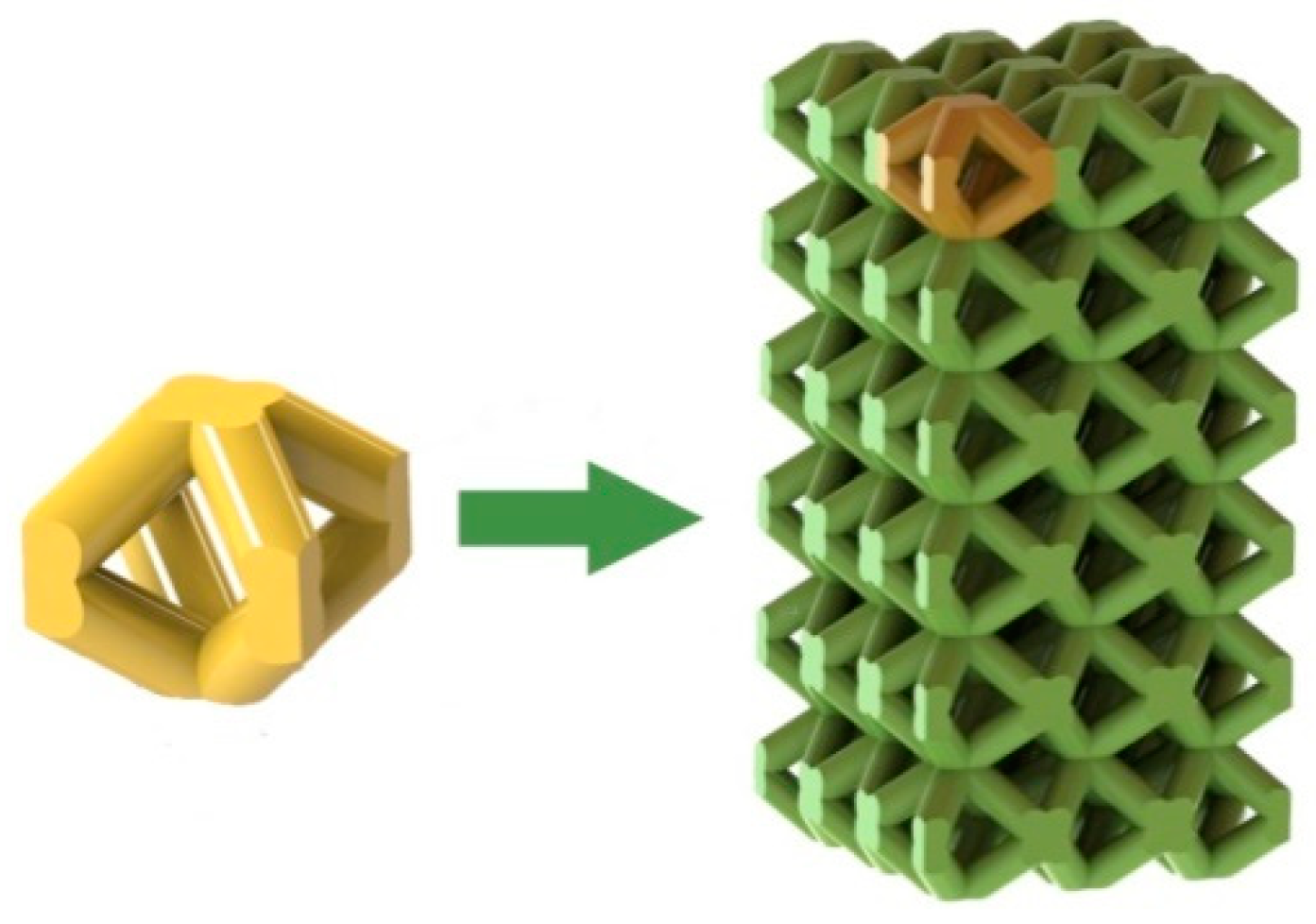
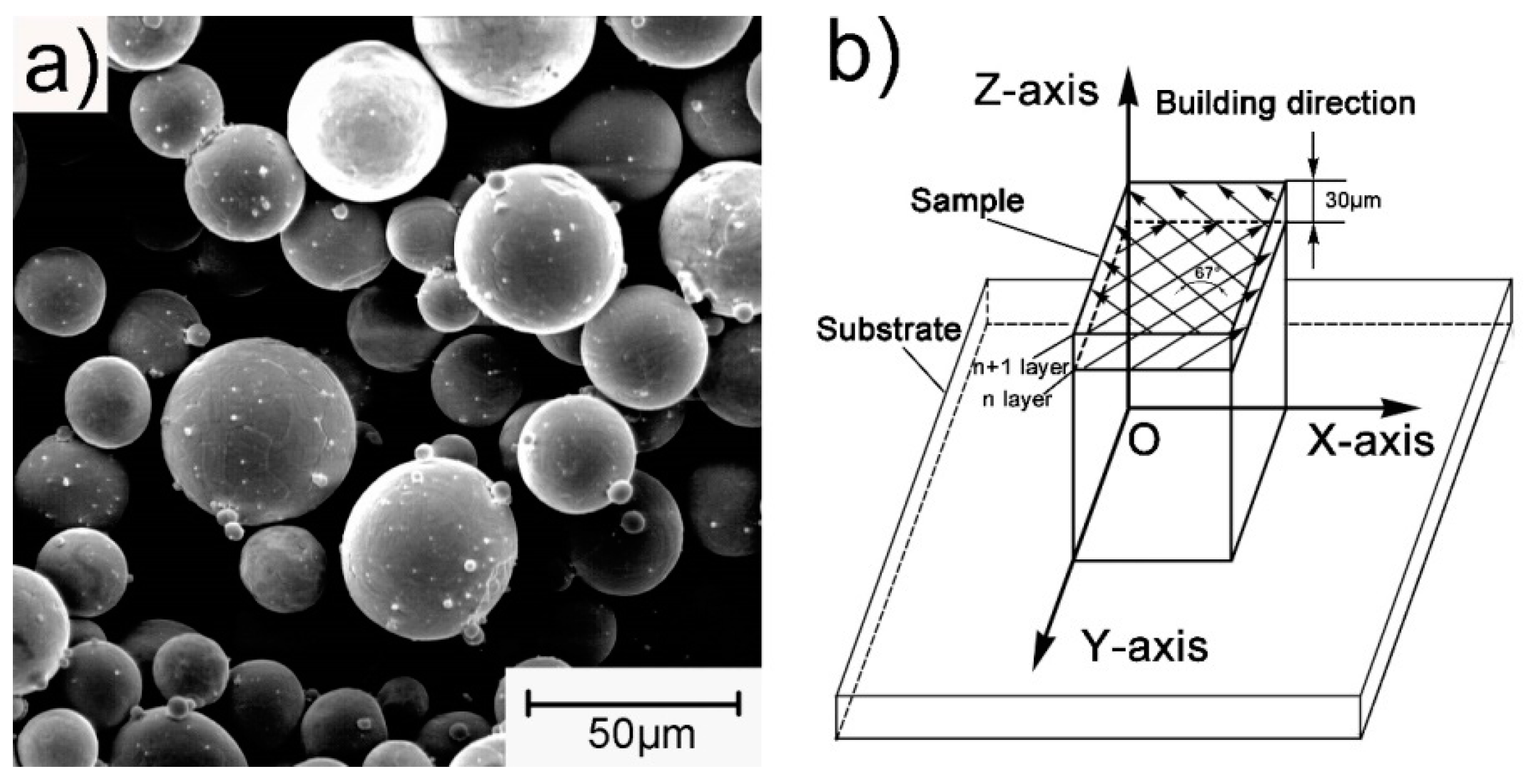

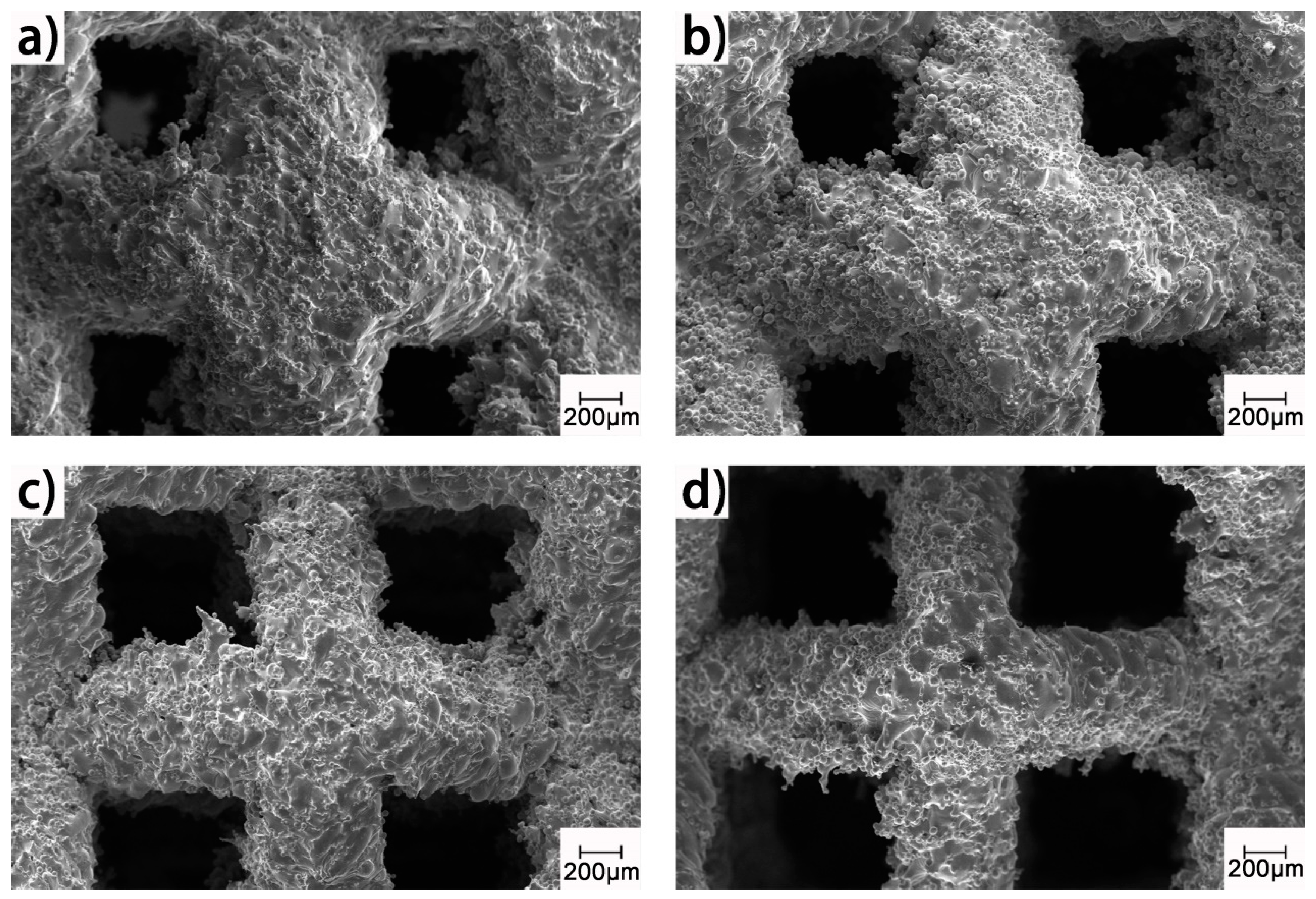
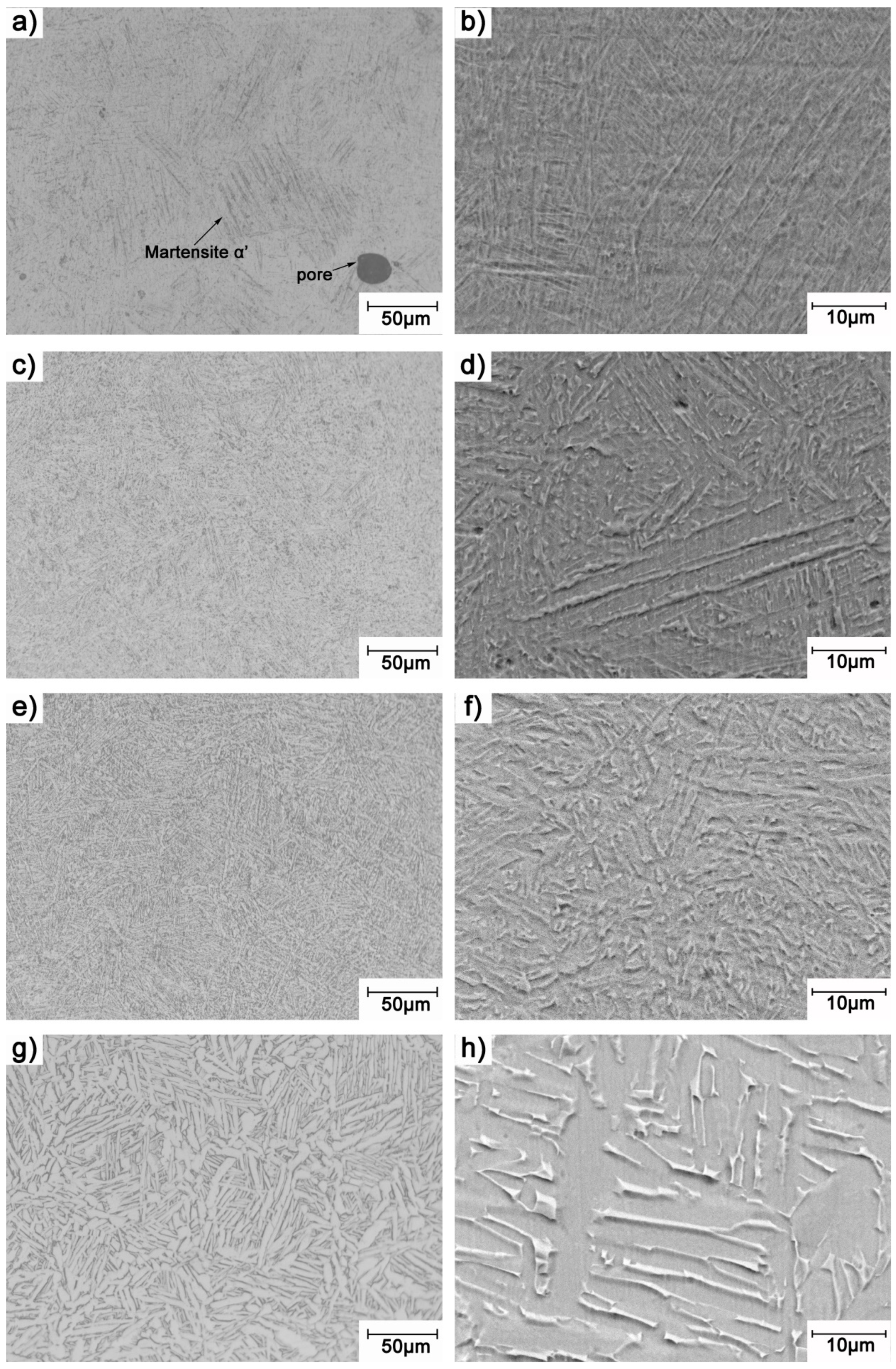
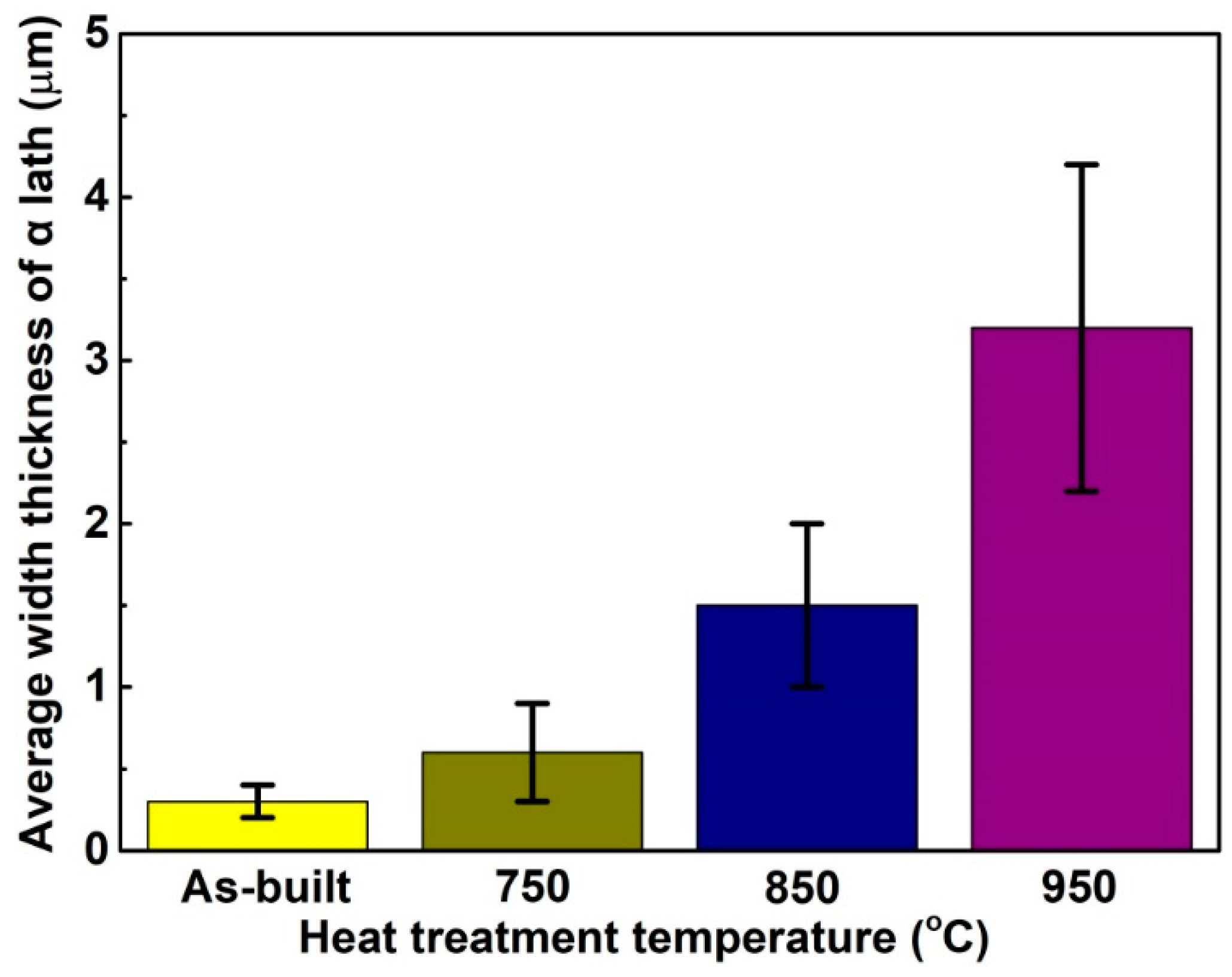

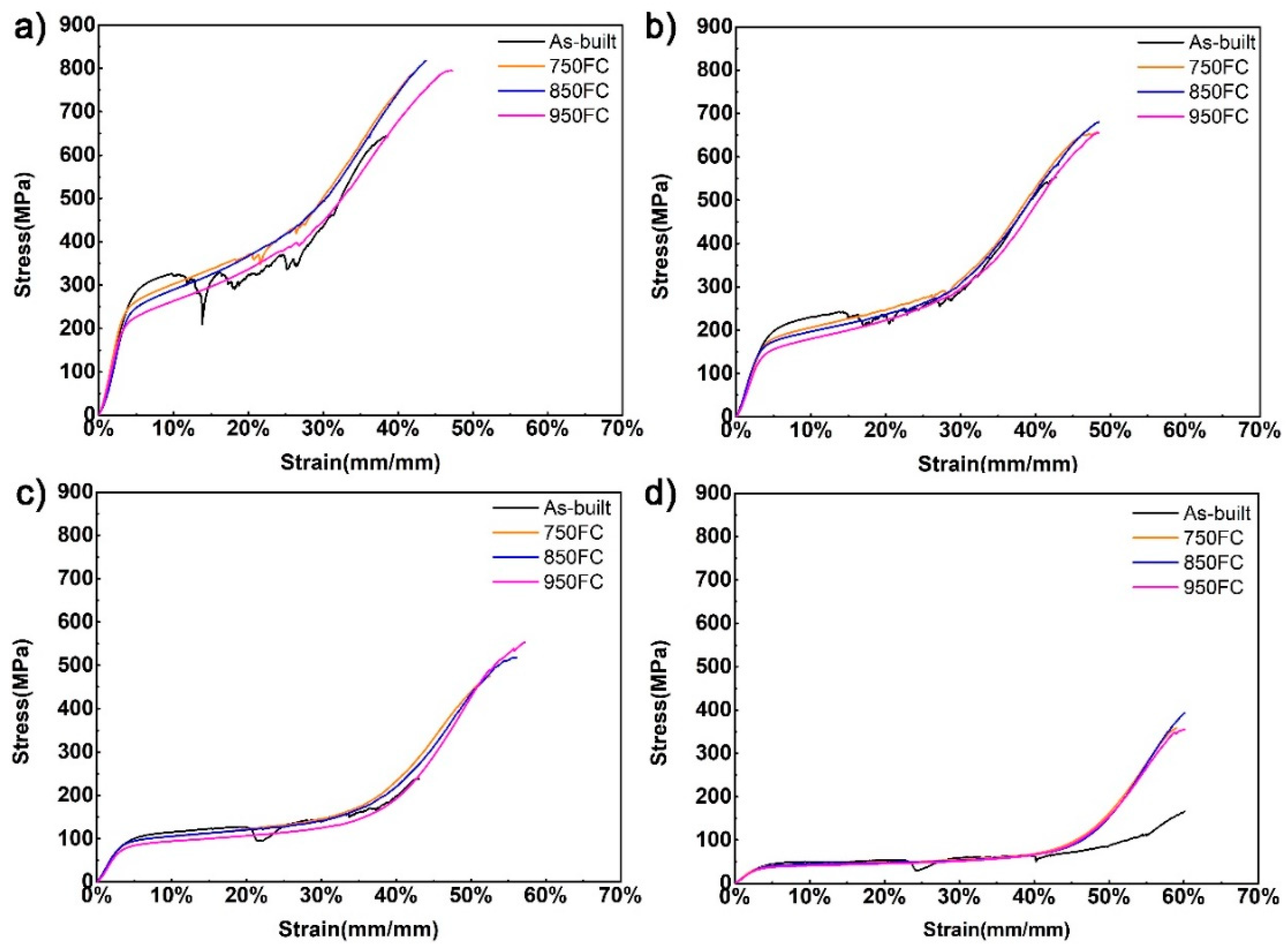



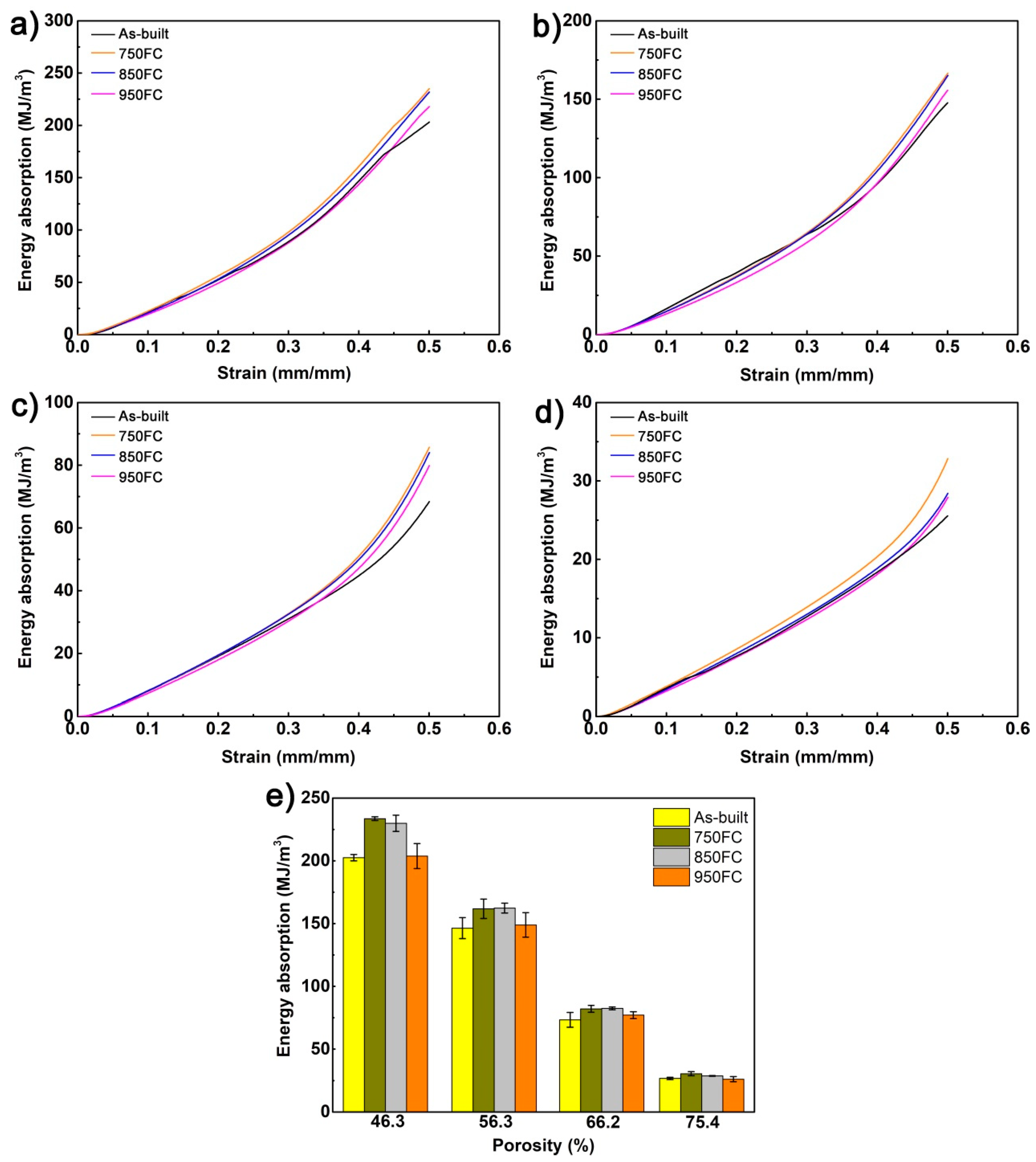
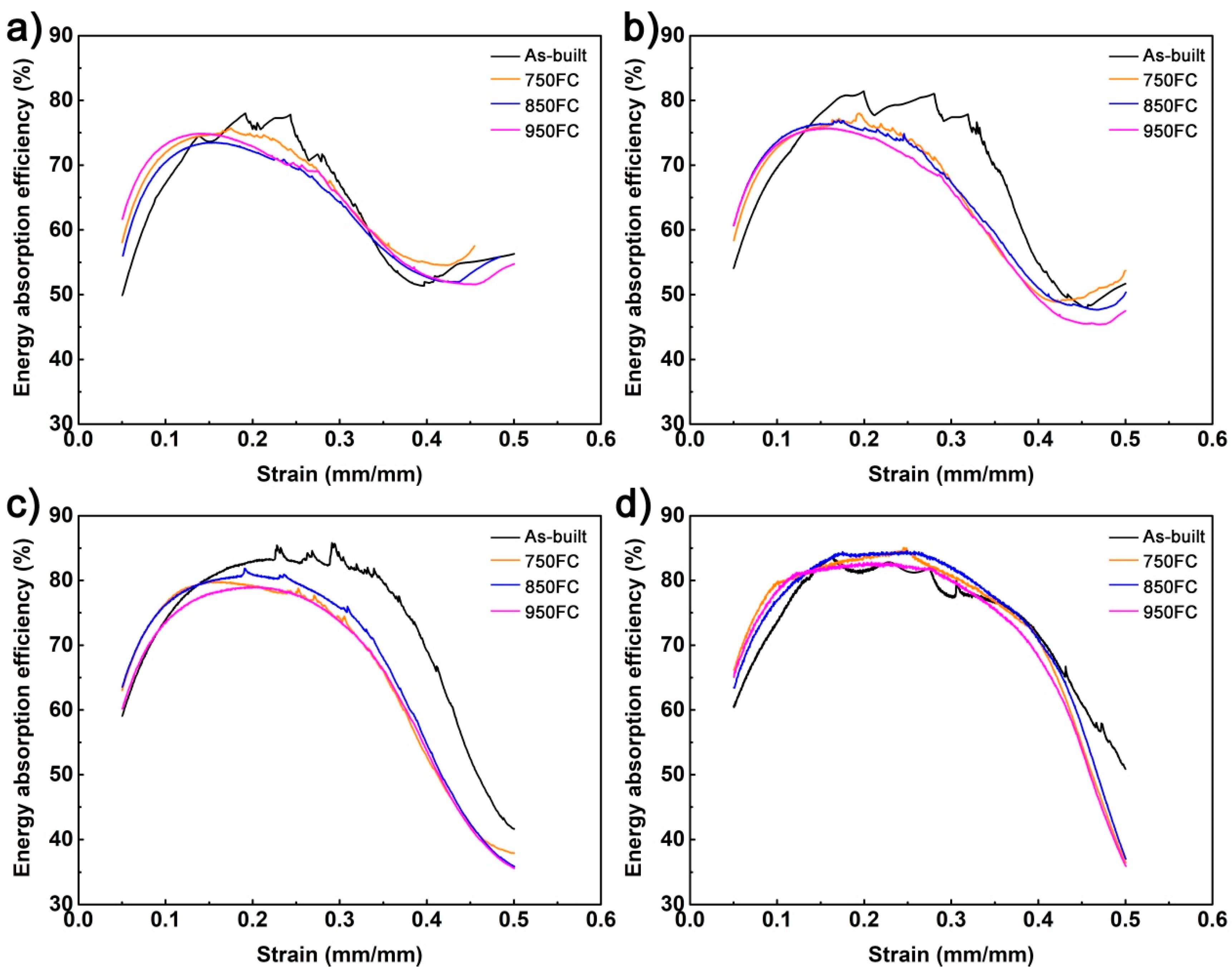
| Element | Ti | Al | V | Fe | C | H | O | N |
|---|---|---|---|---|---|---|---|---|
| Mass (%) | Bal | 5.5 | 3.5 | <0.3 | <0.08 | <0.015 | <0.2 | <0.05 |
| Sample | Design Strut Diameters (μm) | Actual Strut Diameter (μm) | Design Porosity (%) | Actual Porosity (%) |
|---|---|---|---|---|
| 1 | 780 | 802 ± 5 | 46.3 | 43.2 ± 0.5 |
| 2 | 680 | 721 ± 2 | 56.3 | 52.5 ± 1.5 |
| 3 | 580 | 611 ± 3 | 66.2 | 64.8 ± 0.5 |
| 4 | 480 | 508 ± 3 | 75.4 | 74.9 ± 0.1 |
| Sample | Heat Treatment Stemperature (°C) | Design Porosity (%) | Elastic Modulus (GPa) | Compression Stress (MPa) ε = 10% | Plateau Stress (MPa) ε = 20–30% |
|---|---|---|---|---|---|
| 1 | 0 | 46.3 | 6.7 ± 0.7 | 320.6 ± 9.4 | 365.3 ± 12.3 |
| 2 | 56.3 | 4.6 ± 0.1 | 228.2 ± 2.4 | 252.1 ± 7.6 | |
| 3 | 66.2 | 2.7 ± 0.4 | 112.9 ± 4.6 | 126.1 ± 7.4 | |
| 4 | 75.4 | 1.2 ± 0.1 | 47.3 ± 3.1 | 48.6 ± 1.5 | |
| 5 | 750 | 46.3 | 6.8 ± 0.4 | 300.6 ± 3.6 | 420.4 ± 2.6 |
| 6 | 56.3 | 4.4 ± 0.1 | 202.5 ± 0.1 | 265.2 ± 15.9 | |
| 7 | 66.2 | 2.6 ± 0.1 | 104.4 ± 1.7 | 128.9 ± 4.1 | |
| 8 | 75.4 | 1.3 ± 0.2 | 44.7 ± 0.9 | 52.0 ± 1.2 | |
| 9 | 850 | 46.3 | 6.2 ± 0.2 | 287.8 ± 2.7 | 422.1 ± 2.3 |
| 10 | 56.3 | 4.5 ± 0.3 | 196.2 ± 3.5 | 263.4 ± 10.1 | |
| 11 | 66.2 | 2.6 ± 0.1 | 106.0 ± 0.4 | 130.0 ± 1.1 | |
| 12 | 75.4 | 1.2 ± 1.1 | 41.6 ± 4.0 | 46.3 ± 6.4 | |
| 13 | 950 | 46.3 | 6.4 ± 0.7 | 265.9 ± 0.3 | 395.3 ± 22.5 |
| 14 | 56.3 | 4.1 ± 0.4 | 173.4 ± 13.0 | 241.7 ± 26.0 | |
| 15 | 66.2 | 2.3 ± 0.1 | 96.6 ± 2.5 | 119.9 ± 4.5 | |
| 16 | 75.4 | 1.1 ± 0.1 | 36.4 ± 6.6 | 45.8 ± 3.2 |
© 2020 by the authors. Licensee MDPI, Basel, Switzerland. This article is an open access article distributed under the terms and conditions of the Creative Commons Attribution (CC BY) license (http://creativecommons.org/licenses/by/4.0/).
Share and Cite
Yu, G.; Li, Z.; Hua, Y.; Liu, H.; Zhao, X.; Li, W.; Wang, X. The Effects of Post Heat Treatment on the Microstructural and Mechanical Properties of an Additive-Manufactured Porous Titanium Alloy. Materials 2020, 13, 593. https://doi.org/10.3390/ma13030593
Yu G, Li Z, Hua Y, Liu H, Zhao X, Li W, Wang X. The Effects of Post Heat Treatment on the Microstructural and Mechanical Properties of an Additive-Manufactured Porous Titanium Alloy. Materials. 2020; 13(3):593. https://doi.org/10.3390/ma13030593
Chicago/Turabian StyleYu, Guisheng, Zhibin Li, Youlu Hua, Hui Liu, Xueyang Zhao, Wei Li, and Xiaojian Wang. 2020. "The Effects of Post Heat Treatment on the Microstructural and Mechanical Properties of an Additive-Manufactured Porous Titanium Alloy" Materials 13, no. 3: 593. https://doi.org/10.3390/ma13030593
APA StyleYu, G., Li, Z., Hua, Y., Liu, H., Zhao, X., Li, W., & Wang, X. (2020). The Effects of Post Heat Treatment on the Microstructural and Mechanical Properties of an Additive-Manufactured Porous Titanium Alloy. Materials, 13(3), 593. https://doi.org/10.3390/ma13030593





